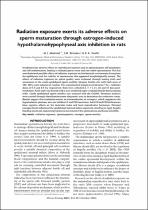 ResearchSpace
ResearchSpace
Radiation exposure exerts its adverse effects on sperm maturation through estrogen-induced hypothalamohypophyseal axis inhibition in rats
JavaScript is disabled for your browser. Some features of this site may not work without it.
- ResearchSpace
- →
- Research Publications/Outputs
- →
- Journal Articles
- →
- View Item
| dc.contributor.author |
Makinta, MJ

|
en_US |
| dc.contributor.author |
Brinders, JM

|
en_US |
| dc.contributor.author |
Smith, KA

|
en_US |
| dc.date.accessioned | 2007-03-28T07:56:35Z | en_US |
| dc.date.accessioned | 2007-06-07T10:06:18Z | |
| dc.date.available | 2007-03-28T07:56:35Z | en_US |
| dc.date.available | 2007-06-07T10:06:18Z | |
| dc.date.copyright | en_US | |
| dc.date.issued | 2005-10 | en_US |
| dc.identifier.citation | Makinta, MJ, Brinders, JM and Smith, KA. 2005. Radiation exposure exerts its adverse effects on sperm maturation through estrogen-induced hypothalamohypophyseal axis inhibition in rats. African Zoology, vol. 40(2), pp 243-251 | en_US |
| dc.identifier.issn | 1562-7020 | en_US |
| dc.identifier.uri | http://hdl.handle.net/10204/2136 | en_US |
| dc.identifier.uri | http://hdl.handle.net/10204/2136 | |
| dc.description.abstract | Irradiation has adverse effects on reproductive aspects such as spermatogenic cell population and cell malformation, leading to reduced sperm count and non-viable spermatozoa. This has overshadowed possible effects of radiation exposure on biochemical environment throughout the epididymis and the viability of spermatozoa that appeared morphologically normal. The effects of radiation exposure on sperm quality were evaluated through mating trials and assessment of the cauda epididymal sperm motility. Sprague Dawley rats with body mass of 300-400 g were selected at random. Two experimental groups received acute 6 degrees Co gamma-radiation doses of 3.5 and 6.0 Gy, respectively. Data were collected 2, 7, 14, 21, 28 and 35 days post-irradiation. Each male was housed with a non-irradiated super-ovulated female during mating trials. Cauda epididymal sperm motility was assessed with the CASMA. Hormone analyses were carried through chemiluminescence diagnostic tests to determine the endocrine status. Results suggest that irradiation causes an overproduction of estrogens, which suppresses the hypothalamic-pituitary axis and inhibits LH and FSH secretions. Both LH and FSH deficiencies have negative effects on the testicular index and local reproductive hormones. Elevated estrogen levels influenced the epididymal internal milieu negatively, resulting in rigid, flagella bending sperm tail, impaired progressive movement of the spermatozoa and hence infertility. | en_US |
| dc.format.extent | 311501 bytes | en_US |
| dc.format.mimetype | application/pdf | en_US |
| dc.language.iso | en | en_US |
| dc.publisher | Zoological Society of Southern Africa | en_US |
| dc.rights | Copyright: 2005 Zoological Society of Southern Africa | en_US |
| dc.source | en_US | |
| dc.subject | Radiation exposure | en_US |
| dc.subject | Spermiogenesis | en_US |
| dc.subject | Estrogen | en_US |
| dc.subject | Sperm motility | en_US |
| dc.subject | Zoology | en_US |
| dc.title | Radiation exposure exerts its adverse effects on sperm maturation through estrogen-induced hypothalamohypophyseal axis inhibition in rats | en_US |
| dc.type | Article | en_US |
| dc.identifier.apacitation | Makinta, M., Brinders, J., & Smith, K. (2005). Radiation exposure exerts its adverse effects on sperm maturation through estrogen-induced hypothalamohypophyseal axis inhibition in rats. http://hdl.handle.net/10204/2136 | en_ZA |
| dc.identifier.chicagocitation | Makinta, MJ, JM Brinders, and KA Smith "Radiation exposure exerts its adverse effects on sperm maturation through estrogen-induced hypothalamohypophyseal axis inhibition in rats." (2005) http://hdl.handle.net/10204/2136 | en_ZA |
| dc.identifier.vancouvercitation | Makinta M, Brinders J, Smith K. Radiation exposure exerts its adverse effects on sperm maturation through estrogen-induced hypothalamohypophyseal axis inhibition in rats. 2005; http://hdl.handle.net/10204/2136. | en_ZA |
| dc.identifier.ris | TY - Article AU - Makinta, MJ AU - Brinders, JM AU - Smith, KA AB - Irradiation has adverse effects on reproductive aspects such as spermatogenic cell population and cell malformation, leading to reduced sperm count and non-viable spermatozoa. This has overshadowed possible effects of radiation exposure on biochemical environment throughout the epididymis and the viability of spermatozoa that appeared morphologically normal. The effects of radiation exposure on sperm quality were evaluated through mating trials and assessment of the cauda epididymal sperm motility. Sprague Dawley rats with body mass of 300-400 g were selected at random. Two experimental groups received acute 6 degrees Co gamma-radiation doses of 3.5 and 6.0 Gy, respectively. Data were collected 2, 7, 14, 21, 28 and 35 days post-irradiation. Each male was housed with a non-irradiated super-ovulated female during mating trials. Cauda epididymal sperm motility was assessed with the CASMA. Hormone analyses were carried through chemiluminescence diagnostic tests to determine the endocrine status. Results suggest that irradiation causes an overproduction of estrogens, which suppresses the hypothalamic-pituitary axis and inhibits LH and FSH secretions. Both LH and FSH deficiencies have negative effects on the testicular index and local reproductive hormones. Elevated estrogen levels influenced the epididymal internal milieu negatively, resulting in rigid, flagella bending sperm tail, impaired progressive movement of the spermatozoa and hence infertility. DA - 2005-10 DB - ResearchSpace DP - CSIR KW - Radiation exposure KW - Spermiogenesis KW - Estrogen KW - Sperm motility KW - Zoology LK - https://researchspace.csir.co.za PY - 2005 SM - 1562-7020 T1 - Radiation exposure exerts its adverse effects on sperm maturation through estrogen-induced hypothalamohypophyseal axis inhibition in rats TI - Radiation exposure exerts its adverse effects on sperm maturation through estrogen-induced hypothalamohypophyseal axis inhibition in rats UR - http://hdl.handle.net/10204/2136 ER - | en_ZA |





